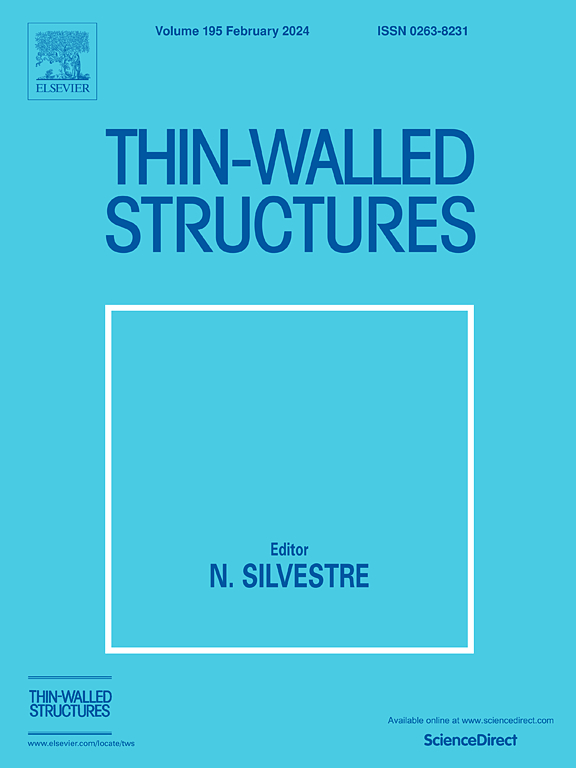An equivalent average shear stress yield criterion based on Simpson's numerical integration rule and its application in burst pressure analysis of thin-walled pipelines
IF 5.7
1区 工程技术
Q1 ENGINEERING, CIVIL
引用次数: 0
Abstract
Pipelines are a crucial transportation infrastructure for the long-distance transport of natural gas, oil, and other hydrocarbons, typically conducted through thin-walled pipes (). Accurate prediction of the burst pressure of thin-walled pipelines is essential for their safe and reliable operation. To enhance the prediction accuracy of the burst pressure for defect-free, straight, thin-walled pipes, a new numerical integration yield criterion was proposed between the Tresca and Mises criteria, using the mean value of Simpson's numerical integration (MSI) as the equivalent shear stress. A new burst pressure prediction formula was then constructed using the MSI yield criterion. The burst pressure predictions based on different yield criteria were compared with experimental data. Additionally, the burst pressure curves of the new prediction formula were plotted, and the relative errors between the new prediction formula and four existing prediction formulas were analyzed and compared. The results indicate that the new burst pressure prediction formula using the MSI yield criterion closely matches the experimental data, with the best relative error result within a confidence interval of ±1.3 %. The Lord parameter curve and plane stress curve of the MSI yield criterion exhibit good consistency with the experimental data of various ductile metal materials. The new burst pressure formula established by incorporating the MSI criterion provides a safe, economical, and reliable theoretical foundation for the design, manufacture, inspection, and safety assessment of thin-walled pipelines in production practice.
基于辛普森数值积分规则的等效平均剪应力屈服准则及其在薄壁管道爆破压力分析中的应用
管道是长距离输送天然气、石油和其他碳氢化合物的重要运输基础设施,通常通过薄壁管道(D/t≥20)进行输送。准确预测薄壁管道的爆破压力对其安全可靠运行至关重要。为了提高对无缺陷直薄壁管道爆破压力的预测精度,在 Tresca 和 Mises 准则之间提出了一种新的数值积分屈服准则,使用辛普森数值积分平均值 (MSI) 作为等效剪应力。然后利用 MSI 屈服准则构建了新的爆破压力预测公式。将基于不同屈服准则的爆破压力预测值与实验数据进行了比较。此外,还绘制了新预测公式的爆破压力曲线,并分析和比较了新预测公式与四种现有预测公式之间的相对误差。结果表明,使用 MSI 屈服准则的新爆破压力预测公式与实验数据非常吻合,最佳相对误差结果的置信区间为 ±1.3%。MSI 屈服准则的主参数曲线和平面应力曲线与各种韧性金属材料的实验数据具有良好的一致性。结合 MSI 准则建立的新爆破压力公式为生产实践中薄壁管道的设计、制造、检验和安全评估提供了安全、经济和可靠的理论基础。
本文章由计算机程序翻译,如有差异,请以英文原文为准。
求助全文
约1分钟内获得全文
求助全文
来源期刊

Thin-Walled Structures
工程技术-工程:土木
CiteScore
9.60
自引率
20.30%
发文量
801
审稿时长
66 days
期刊介绍:
Thin-walled structures comprises an important and growing proportion of engineering construction with areas of application becoming increasingly diverse, ranging from aircraft, bridges, ships and oil rigs to storage vessels, industrial buildings and warehouses.
Many factors, including cost and weight economy, new materials and processes and the growth of powerful methods of analysis have contributed to this growth, and led to the need for a journal which concentrates specifically on structures in which problems arise due to the thinness of the walls. This field includes cold– formed sections, plate and shell structures, reinforced plastics structures and aluminium structures, and is of importance in many branches of engineering.
The primary criterion for consideration of papers in Thin–Walled Structures is that they must be concerned with thin–walled structures or the basic problems inherent in thin–walled structures. Provided this criterion is satisfied no restriction is placed on the type of construction, material or field of application. Papers on theory, experiment, design, etc., are published and it is expected that many papers will contain aspects of all three.
 求助内容:
求助内容: 应助结果提醒方式:
应助结果提醒方式:


